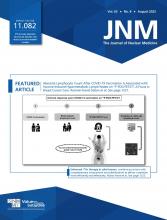Markus Schwaiger, MD (right), receives de Hevesy Award from Richard L. Wahl, MD.
Markus Schwaiger, MD, a scientist known for his contributions to cardiac PET imaging, was named on June 12 as the 2022 recipient of the Georg Charles de Hevesy Nuclear Pioneer Award, presented by SNMMI at its 2022 Annual Meeting in Vancouver, Canada. Schwaiger was recognized for his significant work in multimodal imaging to visualize and quantify biologic processes. He played a key role in the advancement of nuclear cardiology, focusing on molecular mechanisms to develop novel quantitative methods and radiotracers. His translational approach included both preclinical and clinical trials, resulting in the creation of novel diagnostic and image-guided therapeutic paradigms. Schwaiger’s research interests also included oncologic PET, as well as the diagnosis and treatment of thyroid endocrine and neuroendocrine diseases.
“Dr. Schwaiger has proven himself a scientific, clinical, educational, and administrative leader throughout his entire career,” said 2021–2022 SNMMI President Richard L. Wahl, MD. “From his work in establishing PET as the standard for myocardial viability to his pioneering role in PET/MR imaging, his training of new generations of nuclear medicine leaders, and his establishment of centers of excellence at the Technical University of Munich, his dedication to the field has profoundly changed the way we practice nuclear medicine and molecular imaging.”
Schwaiger completed his medical studies at the University of Freiburg and the Freie Universität Berlin (both in Germany). He completed a postdoctoral fellowship at the University of Cincinnati (OH) and returned to Germany as a resident at the Deutsches Herzzentrum München. From there, his career took him to the University of California, Los Angeles, where, as a fellow and assistant professor, he utilized PET to contribute novel insights to the field of cardiology. In 1986, Schwaiger moved to the University of Michigan (Ann Arbor), where he led the nuclear cardiology and cardiac PET program. He returned to Germany in 1993, serving as the director of the Department of Nuclear Medicine at the Klinikum Rechts der Isar of the Technische Universität München. He became the medical director and CEO there in 2016 and retired in 2021.
Each year since 1960, SNMMI has presented the de Hevesy Award to an individual for outstanding contributions to the field of nuclear medicine. De Hevesy received the 1943 Nobel Prize in chemistry for his work in determining the absorption, distribution, metabolism, and elimination of radioactive compounds in the human body. His work led to the foundation of nuclear medicine as a tool for diagnosis and therapy. The list of previous recipients of this award includes numerous Nobel laureates—such as Ernest Lawrence, PhD, who built the world’s first cyclotron for production of radionuclides, and Glenn Seaborg, PhD, who discovered more than half a dozen new elements.
“I am honored to receive SNMMI’s Georg Charles de Hevesy Nuclear Medicine Pioneer Award,” said Schwaiger. “At every stage throughout my career I have had the pleasure of working with very talented colleagues who inspired and supported me. Together we have advanced the field of nuclear medicine and molecular imaging. Now, I am excited to observe and to applaud what the next generation of researchers in nuclear medicine will discover.”
- © 2022 by the Society of Nuclear Medicine and Molecular Imaging.








